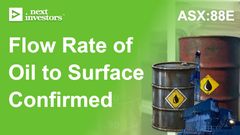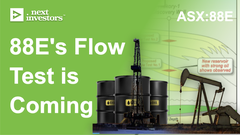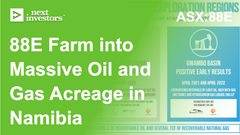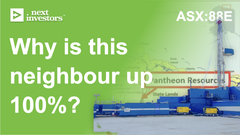Oil prices soar after Saudi oil facility attack
Hey! Looks like you have stumbled on the section of our website where we have archived articles from our old business model.
In 2019 the original founding team returned to run Next Investors, we changed our business model to only write about stocks we carefully research and are invested in for the long term.
The below articles were written under our previous business model. We have kept these articles online here for your reference.
Our new mission is to build a high performing ASX micro cap investment portfolio and share our research, analysis and investment strategy with our readers.
Click Here to View Latest Articles
A drone strike on a Saudi Arabian Aramco oil facility on Saturday cut the country’s oil production in half and removed about 5% of global supplies resulting in the biggest oil price surge on record.
The supply disruption is the biggest to ever hit the global oil supply, topping Saddam Hussein's invasion of Kuwait in 1990. It also exceeds the loss of Iranian oil output in 1979 during the Islamic Revolution, according to the US Department of Energy.
Saudi Arabia produces approximately one-tenth of the world's crude oil and it’s believed that around half of the country’s production, or five million barrels a day, has been disrupted.
Brent Crude opened almost 20% higher in London following the strike. The almost US$12 per barrel jump in Brent futures, in the seconds after the open on Monday, was the biggest intraday (dollar) advance since they were launched in 1988.
On the New York Mercantile Exchange, West Texas Intermediate (WTI) contracts were frozen for about two minutes after the scale of the move delayed the market open.
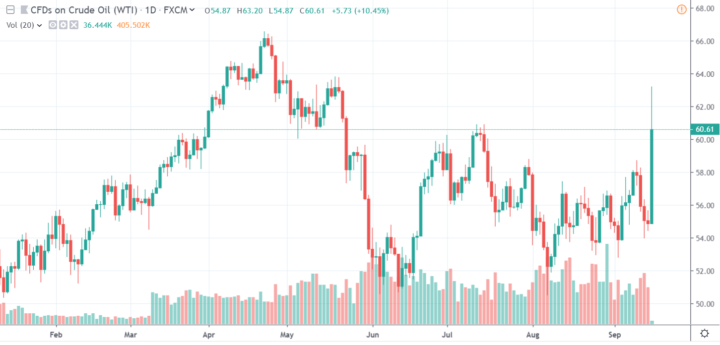
Iran-backed Houthi rebels in Yemen, who’ve launched several drone attacks on Saudi targets in the past, claimed responsibility for the drone strike. However, the US has pointed the finger at Iran, while Iraqi media claim the attack on Saudi oil facilities came from Iraq. Baghdad has denied this.
The S&P/ASX Energy Index was up 4.2% intraday Monday after finishing last week at 10583.5 points, the highest closing level since early August. Even prior to news of the strike, the index had already rallied 6.7% over the past four weeks. Given that the Saudi outage could last for months, there could be further oil prices rises ahead.
Goldman Sachs commodity strategist Damien Courvalin, laid out four possible scenarios and the possible oil price response for each:
- “A very short outage – a week for example – would likely drive long-dated prices higher to reflect a growing risk premium, although short of what occurred last fall given a de-bottlenecked Permian shale basin, a weaker growth outlook and prospects of strong non-OPEC production growth in 2020. Such a price impact could likely be of $3-5/bbl.
- “An outage at current levels of two to six weeks would, in addition to this move in long-dated prices, see a steepening of the Brent forward curve (2-mo vs. 3-year forward) of $2 to $9/bbl respectively. All in, the expected price move would be between $5 and $14/bbl, commensurate to the length of the outage(a six month outage of 1 mb/d would be similar to a six week one at current levels).
- “Should the current level of outage be announced to last for more than six weeks, we expect Brent prices to quickly rally above $75/bbl, a level at which we believe an SPR release would likely be implemented, large enough to balance such a deficit for several months and cap prices at such levels.
- “An extreme net outage of a 4 mb/d for more than three months would likely bring prices above $75/bbl to trigger both large shale supply and demand responses.”
It’s uncertain how long it takes Saudi Aramco facilities to come back online, leaving scope for other producers to fill any void from disruption to Saudi production.
But while limited supply and higher oil prices is not great news for consumers, it is welcomed by oil companies.
ASX and London listed oil exploration company 88 Energy (ASX:88E) is one such company that would benefit from higher oil prices.
The company is currently in preparations to drill the Charlie-1 (Malguk-1 appraisal) well at its conventional Icewine Project in the proven Alaska North Slope basin.
88E will test multiple stacked conventional targets, as well as the HRZ shale, in the first quarter of next year. This drilling at the Charlie-1 well will be a pivotal moment for the company as it seeks to unlock the large potential of the conventional plays on the acreage.
88 Energy recently secured a farm-out partner in London-based Premier Oil Plc (LON:PMO), which agreed to bankroll 88 Energy’s conventional Icewine Project.
Terms of the farmout agreement were signed in late August, and give Premier a 60% interest in the precinct known as Area A, with 88 Energy retaining a 30% holding. The remaining 10% will be held by 88 Energy’s joint-venture partner, Houston-based Burgundy Xploration.
Drilling at the Charlie-1 well in Area A is on target to commence within six months, with Premier Oil contributing up to US$23 million (A$33.5M), and 88 Energy retaining operational rights to the project.
General Information Only
S3 Consortium Pty Ltd (S3, ‘we’, ‘us’, ‘our’) (CAR No. 433913) is a corporate authorised representative of LeMessurier Securities Pty Ltd (AFSL No. 296877). The information contained in this article is general information and is for informational purposes only. Any advice is general advice only. Any advice contained in this article does not constitute personal advice and S3 has not taken into consideration your personal objectives, financial situation or needs. Please seek your own independent professional advice before making any financial investment decision. Those persons acting upon information contained in this article do so entirely at their own risk.
Conflicts of Interest Notice
S3 and its associated entities may hold investments in companies featured in its articles, including through being paid in the securities of the companies we provide commentary on. We disclose the securities held in relation to a particular company that we provide commentary on. Refer to our Disclosure Policy for information on our self-imposed trading blackouts, hold conditions and de-risking (sell conditions) which seek to mitigate against any potential conflicts of interest.
Publication Notice and Disclaimer
The information contained in this article is current as at the publication date. At the time of publishing, the information contained in this article is based on sources which are available in the public domain that we consider to be reliable, and our own analysis of those sources. The views of the author may not reflect the views of the AFSL holder. Any decision by you to purchase securities in the companies featured in this article should be done so after you have sought your own independent professional advice regarding this information and made your own inquiries as to the validity of any information in this article.
Any forward-looking statements contained in this article are not guarantees or predictions of future performance, and involve known and unknown risks, uncertainties and other factors, many of which are beyond our control, and which may cause actual results or performance of companies featured to differ materially from those expressed in the statements contained in this article. S3 cannot and does not give any assurance that the results or performance expressed or implied by any forward-looking statements contained in this article will actually occur and readers are cautioned not to put undue reliance on forward-looking statements.
This article may include references to our past investing performance. Past performance is not a reliable indicator of our future investing performance.



